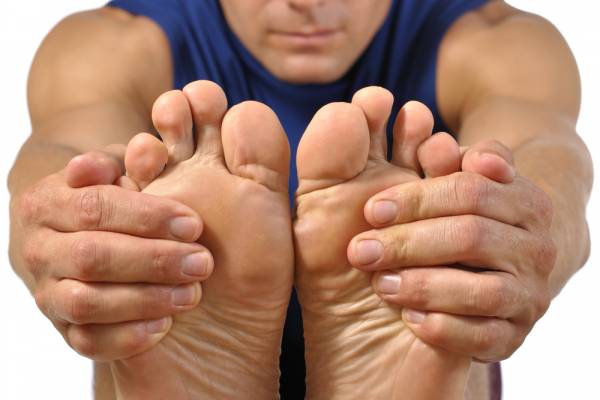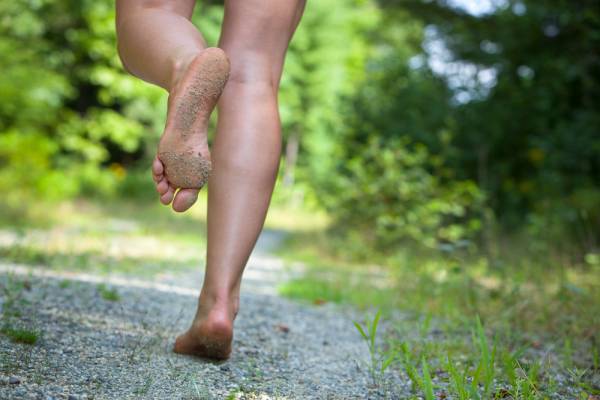If you’re reading this, I know you’re into fitness. You like learning how to improve yourself and your training. You probably train your chest, your hips, your back and all the other major muscle groups. But, how often do you train your feet?
Maybe you’re thinking that is a ludicrous thought. I mean, your feet are something that take you from point A to point B, right? You don’t need to train them. Oh, but how wrong you are.
RELATED: Understanding and Caring for Your Feet
If you don’t believe me, read on – because I’m going to tell you the two most important reasons you should be training barefoot and how to safely transition to ditching those socks and shoes. But first, I’m going to explain what you’re doing right now that’s got your feet so messed up to begin with.
Your Feet Are Your Foundation
Your feet are your foundation, your base of support. Think about it: your feet are the only part of your anatomy that comes in contact with the ground. All of the force that you transmit through your entire body goes through your feet. Your feet help transmit these forces, balance you, and are also key to movement.
But what do you do to our feet all day? You cram them in shoes. You limit their mobility and take away the sensory input they provide you. And you try to correct issues you think you have such as flat feet or high arches.
“All of the force that you transmit through your entire body goes through your feet.”
Here’s the thing. There are 28 bones in your foot, twenty muscles, and over thirty joints. Simply picking the “right shoe” isn’t the end of what you need to do for your feet. Remember, the body doesn’t work in isolation. It is all connected. Any decrease in strength, mobility, or proprioception in your foot doesn’t end there. It impacts your leg, your hip, your pelvis, and so on. And just like with any other muscle, disuse can lead to atrophy and decreased muscle activation.
RELATED: 4 Common Foot Injuries in the Athlete
So, you need to work on your feet. And one of the best ways to do this is to do your strength and conditioning training barefoot. Lift weights barefoot. Do your conditioning barefoot. Warm up and cool down barefoot.
Now, here are the two reasons you should be training barefoot, specifically as it relates to your performance (and getting better performance).
Training Barefoot Increases Sensory Input
When you are wearing a shoe, or even a sock, you are changing the sensory input your brain receives from the ground. When you are barefoot, you get tons of input all about the surface you are standing on, the position of your joints, and the tension of your muscles.
RELATED: At the Core of It: Creating Strength and Tension in the Body
Put on a sock or a shoe, and you lose a significant amount of this information. This then means your foot can’t work efficiently. Some muscles shut off because they don’t have to work due to the support of the shoe, while others work too hard or at the wrong time. This influences how the rest of your muscles work up the entire kinetic chain, effectively changing your entire movement pattern throughout your lift.
Imagine wearing gloves all day while you are working. Think of typing with those gloves on. You wouldn’t feel the keys under your fingers, so you wouldn’t know exactly how much force to apply and would likely apply too much.
The same thing happens when you wear shoes on your feet. You can’t sense the ground beneath you, so you end up working inefficiently and compensating with other muscles. This not only affects the strength and mobility of your feet, but it will also influence your entire lift and the force you are able to exert.

Training Barefoot Prevents Injury
By training barefoot, you are improving the strength, mobility, and proprioception of your feet. Proprioception refers to the knowledge of the position and movement of the body, and the ability to react accordingly.
When you wear shoes you lose this proprioceptive input. This means if something unexpected happens – you hit a piece of uneven ground or you make a quick cut while playing sports – your body won’t be able to perceive this change and react accordingly to protect itself from injury.
“The body works as a unit, and an issue in the foot can lead to an injury at a completely different part of your body.”
Try something for me right now. Take off your shoes, stand on one foot with your other in front of you, and close your eyes. Can you stand there fairly easily without falling or flailing all over the place? If not, we need to work on your proprioception.
Beyond proprioception, training barefoot will further prevent injury by improving your foot strength and mobility. This is key because it will prevent your body from compensating with other muscles that will create imbalances, improper muscle recruitment, and poor joint alignment. The body works as a unit, and an issue in the foot can lead to an injury at a completely different part of your body.
Okay, that sounds all fine and good, but won’t I get stress fractures, you ask? Or what if I drop a weight on my foot? Let’s break down these questions so you don’t have to fear these myths anymore.
Myth #1: You Will Get Stress Fractures
Gym folklore says this happens due to increased load and lack of cushion. But this is just not true. Sure, if you go from training in cushioned shoes to running 10km a day barefoot outside, you might have some problems. But that isn’t what I’m telling you to do.
RELATED: Shoes or No Shoes: How and Why to Build Up to Barefoot Running
For all of you who believe you will get stress fractures if you train barefoot, let me remind you of something called Wolff’s Law of Adaptivity. This law was developed by German anatomist and surgeon Julius Wolff (1836-1902) and states that bone in a healthy person or animal will adapt to the loads under which it is placed.
The law explains that if loading on a particular bone increases, then the bone will remodel itself over time to become stronger to resist that sort of loading. The inverse is also true. If loading on a bone decreases, the bone will become weaker, as it is metabolically costly to maintain bone and there is no stimulus for the continued remodeling required to retain that bone mass.
“So basically, if you train barefoot, you will improve the strength of your bones, making them able to withstand more load. But if you constantly wear cushioned shoes, you will make your bones weaker.”
So basically, if you train barefoot, you will improve the strength of your bones, making them able to withstand more load. But if you constantly wear cushioned shoes, you will make your bones weaker. Seems like a no-brainer to train barefoot.
Myth #2: You Will Drop a Weight and Hurt Yourself
Short and sweet here. First, try not to drop a heavy weight on your foot and you will be just fine. I work in a training studio that is almost exclusively barefoot and we have yet to have someone drop a heavy weight on his or her foot and get injured. Why? Because our clients watch what they are doing.
But even still, if you were to drop a weight on your foot, the small amount of fabric provided by a shoe is not going to make a difference. That little cushion isn’t going to be the difference between a fracture and no fracture. Sorry to break it to you, but this reason for wearing shoes is invalid.

How to Transition to Barefoot Training
I implore you try barefoot training. My only rule is that you have to transition slowly. Don’t go from zero to 180. Start with doing your warm up and cool down barefoot. Do that until you feel comfortable. Then, start lifting barefoot. Again, do that until you feel comfortable. Then, when you’re ready, transition your conditioning (sprinting, jumping, etc.) to barefoot.
Not only will you feel the difference in your lifts, but your body will thank you for doing this. And if you’re unsure of how to make the transition, work with a professional who can help you move from stage to stage without risk of injury.
References:
1. Verstegen, M.. “Sport Performance”. A Meeting of the Minds. Perform Better. Phoenix, AZ, US. October 29 2011.
2. Wolff J. The Law of Bone Remodeling. Berlin Heidelberg New York: Springer, 1986 (Translation of the German 1892 edition).
Photo courtesy of Shutterstock.






